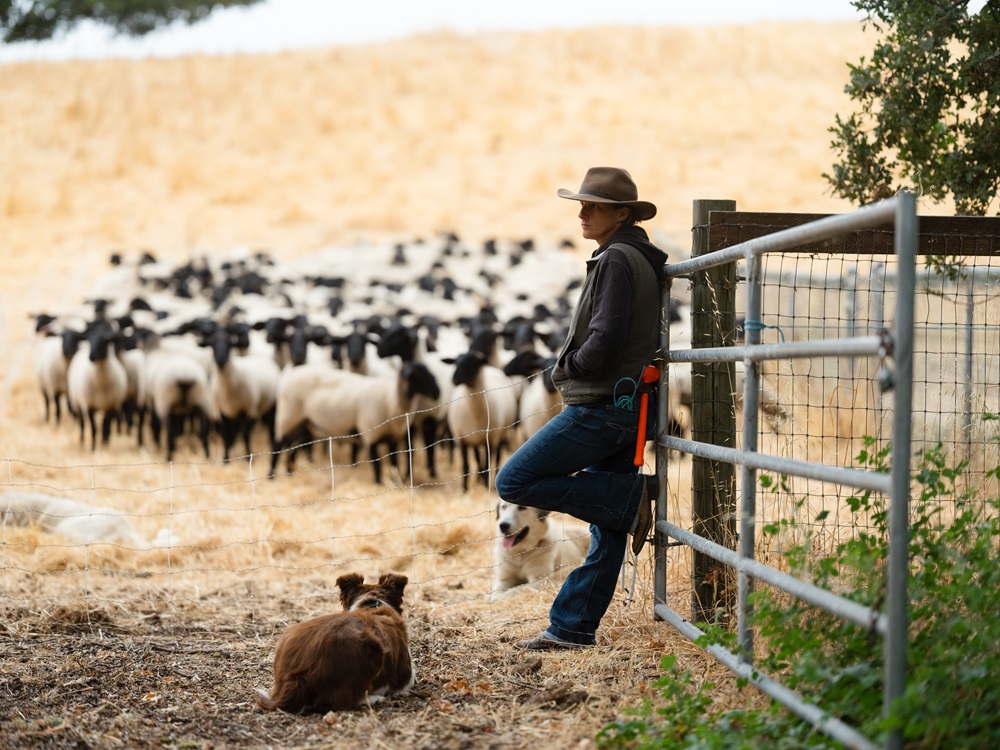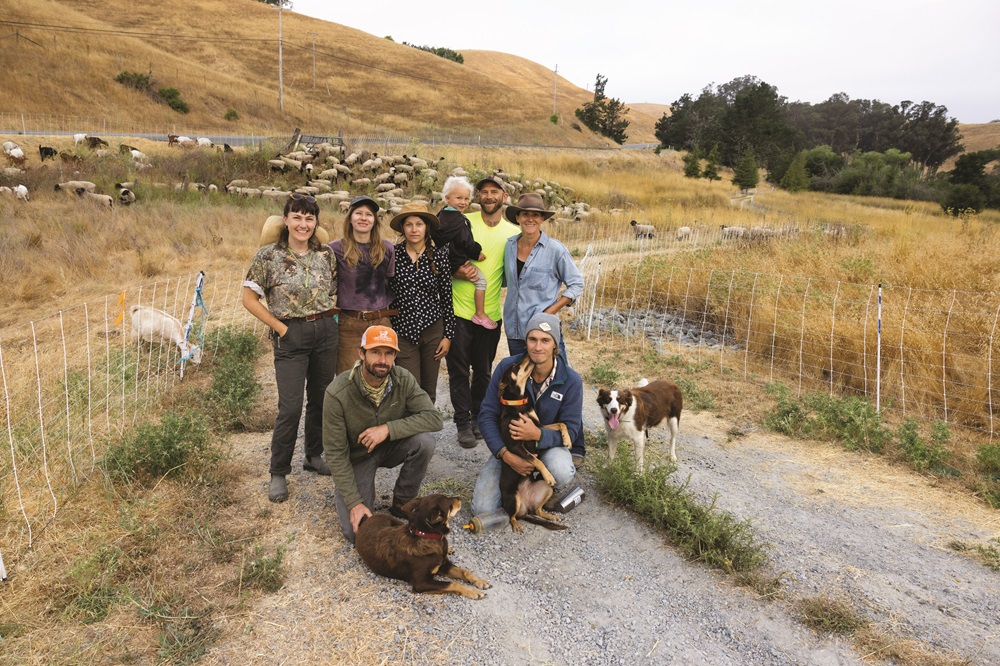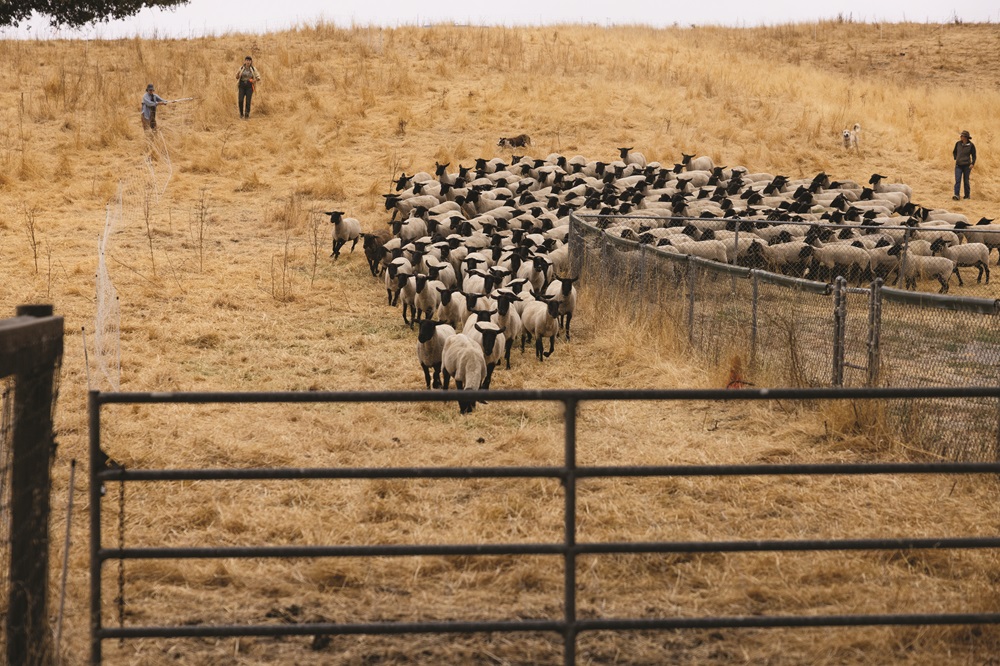Grazing for Good
Mimicking Ancient Migrations for a Healthier Future
PHOTOS BY PAIGE GREEN

With a knife sheathed in her belt on one side and a bright orange mallet on the other, Paigelynn Trotter traverses a steep hillside with a baby strapped to her back, and a livestock guardian dog at her side. She’s studying how 140 goats just grazed down the spring forage where they’d been the day before. Using solar-powered mobile fencing, she moves this herd from one patch of grass to another multiple times a week, escorting them not just around this one property but between several properties throughout the county.
In the summers, these goats are joined by 600 rented sheep, and Trotter is joined by a team of four more women and two more livestock guardian dogs, all part of her grazing business, Coastal Land & Livestock.
The art of shepherding, one of the oldest professions in the world, began long before the conception of private property. Nomadic cultures all over the world moved with their animals based not on permanent fence lines or property rights but by patterns in nature. They’d follow rivers and valleys, grazing more temperate bottomlands in the colder months before leading their herds into the mountains in summer when the grasses up there grew in.
This collective movement of both human and animal, known as “transhumance” replicated the grazing patterns of wild herds. Because ruminants—be they goats, bison or wildebeest—coevolved with grasslands, their cyclical migrations not only provide sustenance for the animals but are also essential to the health of those grasslands.
The advent of fences, highways, and a million property lines has since obstructed this ancient movement for wild herds and domestic flocks alike. But in an attempt to mimic these patterns as much as possible today, Trotter explains how her animals provide “necessary disturbance.” Like wild herds, her animals remove tall annuals and weeds; they crimp the grass into a mulch, allowing for cooler, moister conditions below that promote seed germination; and their hooves lightly till the earth, dropping fertilizer as they go. Healthy grasslands like these have been proven to sequester carbon in their soils, transforming livestock from greenhouse-gas emitters into climate-change mitigators.
The shepherds of antiquity likely followed time-worn traditions more so than logical strategies for land management. Whereas these days, Trotter and her clients begin by negotiating practical goals.
About three quarters of her clients, says Trotter, come to her with just a single objective: fuel load reduction for wildfire prevention. Proper grazing mitigates wildfire risk in dry climates like California, especially on more rugged terrain where machines like mowers can’t reach.
A smaller portion of her clients arrive with more holistic goals, such as better soil health, biodiversity, and the prospect of sequestering carbon. But, regardless, everyone she works with will inevitably end up with these positive results, too. The challenge, she says, is how to explain and quantify the real value of those other, longer-term “ecological services.” Because doing it right requires time, equipment, education, and most importantly, skilled professionals who deserve a livelihood.
Trotter started her career in 2016, right before a slew of local wildfires lifted the profile of grazing practices like hers. Whereas traditional ranching requires owning vast swaths of land, unattainable for young upstarts like her, “contract” or “targeted grazing” offered an entrepreneurial opportunity without the need to inherit property or even purchase all her own infrastructure. Instead, she says, her business is built upon trust, relationships, and social capital. This allows her to rent or contract out most of what she needs, from a livestock trailer to the land itself to entire flocks of sheep.
Arrangements like these used to take place informally between rural neighbors. But more recently, public awareness has grown around the benefits of grazing, particularly in the aftermath of several harrowing wildfire seasons. Since then, new systems have arisen to replicate and broaden the practice. Local Resource Conservation Districts (RCDs) publish a list of local graziers like Trotter, and their “Landsmart” program funds grazing projects on both public and private lands. The University of California Cooperative Extension launched a free online platform called “Match.Graze” that connects livestock producers, graziers and landowners statewide. And in recent years, more regional parks and public agencies have been experimenting with grazing contracts, be it under rural power lines or alongside overgrown highway shoulders in more urban areas, often for purposes of wildfire prevention, though occasionally for ecological health as well.
But as a new generation of grazing professionals like Trotter refine their craft, the financial realities are beginning to set in. Both she and her clients are grappling with exactly what’s required to keep such businesses viable. As a new mother and now as an employer of four other hard-working women, she is no longer able to eke out a scrappy living. Skilled graziers, she explains, are finally beginning to ask for the true cost of their service. And many clients, including public agencies, have been questioning whether they are willing or able to afford such contracts. Meanwhile, every year without fire results in a sort of post-disaster amnesia, meaning less demand for these services, which not only heightens future fire risk but prevents all those other benefits from taking place on the land, too.
In a place like the North Bay, more people are increasingly buying up rangeland without the need nor the intention to ranch it. While in some cases this can result in dangerously unmanaged land, a few of these newer property owners see in graziers a chance to do right by their land. Relying on wealth from more lucrative professions, they don’t balk as much at the true cost of such services, able to invest in land stewardship without the need for immediate payouts from it.
But in order to achieve those larger-scale goals—from fighting climate change to restoring grassland biodiversity—such stewardship practices will need to scale beyond just a few wealthy and benevolent landowners. And we’ll need more practitioners like Trotter, requiring that this work transform from a niche service into a valued profession available everywhere.
For this, our understanding of holistic grazing may need to shift from one of individual private property insurance to one of collective conservation and public good. And even more importantly, as Trotter has discovered, our conception of land itself can no longer be understood in isolation from its tending.

Emma Rohleder, Leland, Donald Pivec, Paigelynn Trotter, Matthew Rose-Stark, and Aaron Gilliam
Glossary:
What is Transhumance?
“Transhumance is a form of pastoralism or nomadism organized around the migration of livestock between mountain pastures in warm seasons and lower altitudes the rest of the year. The seasonal migration may also occur between lower and upper latitudes.” —Brittanica.com


